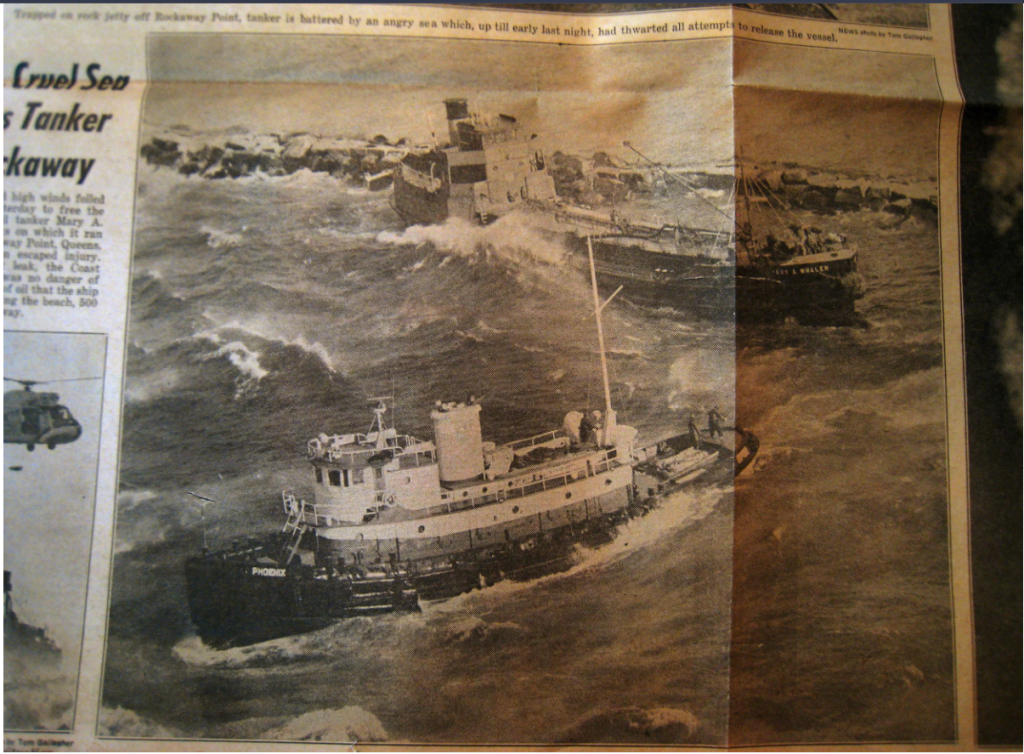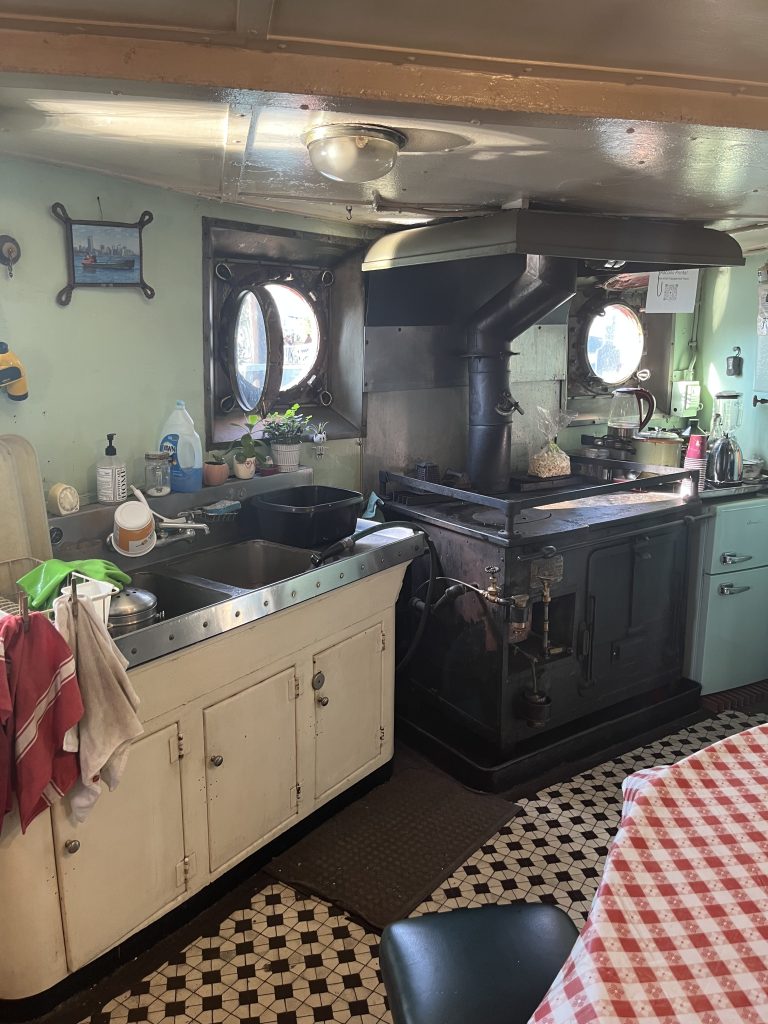The historic tanker ship spotlights Red Hook’s maritime past and its uncertain future.
By COLE SINANIAN
news@queensledger.com
The humble Mary A. Whalen, a small tanker ship moored in Red Hook, pales in comparison to the 1,082 foot-long, 217-foot tall Enchanted Princess cruise ship docked at the adjacent Brooklyn Cruise Terminal. Cruise ships like the Enchanted Princess dock in Red Hook almost weekly, and they’ll often announce their departures and arrivals with a cadence of deafening horns, says Carolina Salguero, who executive directs PortSide, a maritime-advocacy nonprofit based out of the Mary A. Whalen.
It’s a warm, breezy October afternoon, the best kind of day to spend on the water. As part of the citywide Open House NY program, the Mary A. Whalen opened its doors to more than 300 members of the public on Saturday, joining hundreds of public and private spaces across the five boroughs.
Salguero is a protector and advocate for not just the Mary, but the entirety of Red Hook’s Columbia Street waterfront. The area has been in the headlines recently as the City’s Economic Development Corporation (EDC) proceeds with an expansive plan to redevelop the port and build a new neighborhood of luxury condos, a plan that Salguero and her colleagues fear could evict PortSide and erase the neighborhood’s long maritime-industrial history, of which the Mary A. Whalen is one of the last remnants.
The Mary A. Whalen began life in 1938 as a coastal oil tanker, transporting petroleum products for the Brooklyn-based company Ira S. Bushey & Sons from Red Hook throughout the Mid-Atlantic region, regularly travelling as far as the coast of Maine. Much of her work in the mid-20th century was in the New York City area, according to PortSide’s blog, where she would fuel larger ships and sail up the Gowanus Canal or Newtown Creek to deliver oil for heating. She’s now listed in the National Register of Historic Places, partly due to her being one of the last remaining examples of a “bell boat,” a strange kind of configuration that had the captain communicate with crew members in the engine room below via a series of bells and “speaking tubes” to control the boat’s speed and power.
As the 20th-century wore on, fuel demands grew and the Mary, with her relatively small size, struggled to keep up. She was put out of work in 1994 after her engines broke, and was eventually converted to an office for Hughes Marine, a marine industrial supply company. In 2006 PortSide moved in. In 2012, Salguero and a few PortSide staff weathered Hurricane Sandy on the ship, successfully preventing it from running aground in the storm surge, which reached nearly six feet at the Atlantic Basin entrance at Pioneer and Conover Streets.
Which wouldn’t have been the first time. On December 23rd, 1968, the Mary A. Whalen ran aground in the Rockaways. En route from Bayonne, NJ to Island Park, NY, head-on gale-force winds and 10-foot waves, complicated by the fact that the coast guard light at the Rockaways was out, led the Mary A. Whalen straight into the sands of Rockaway Beach. The accident resulted in US vs Reliable Transfer, a landmark 1975 Supreme Court case that established a key principle of modern maritime law: each party in a maritime accident is responsible for paying damages proportional to their culpability, overturning the 50/50 split that had been common practice since the mid-1800s.

The Mary A. Whalen ran aground in the Rockaways in 1968, leading to a major Supreme Court decision. Photo via PortSide.
Below the Mary’s deck, a scrawny black ship cat named Chiclet scampers into her quarters, which is no larger than a walk-in closet and littered with cat food and cleaning supplies. Across the hall is a child’s room with a bunk bed full of plushies and a painting of a jumping sailfish. No children live here, although PortSide keeps the youthful furnishings for its educational visits.
The hallway opens into a cavernous chamber where a ladder descends into a boiler room of knobs and twisting pipes. Cider is boiling in the kitchen, which also serves as PortSide’s main office. A traditional Norwegian sweater, or Lusekofte, hangs on the wall in the hallway. It’s a gift from Karen Dyrland, whose father, a Norwegian named Alf Dyrland, captained the Mary from 1962-1978. He was a member of a near-forgotten immigrant enclave of Norwegian sailors in South Brooklyn who, when not on the water, would spend much of their time packing the saloons and seamans’ dive bars that once crowded Red Hook’s Hamilton Ave. According to A.N. Rygg’s 1941 book, Norwegians in New York, the era between 1870 and 1910 saw the peak of Hamilton Ave’s status as a cultural hub, rendezvous and drinking destination for the Norwegian sailors of Brooklyn. At one point, Brooklyn had the 3rd-largest population of Norwegian speakers in the world and the largest outside Norway.

The kitchen on the Mary A. Whalen. Photo by Cole Sinanian.
To Salguero, this maritime history is a crucial part of Red Hook’s heritage. She edits a blog called “Red Hook Water Stories,” which positions the city’s ports and waterways as “a language New York City has forgotten.” In one of her monologues to visitors on Saturday, Salguero explained that the City’s plans to develop the area put PortSide, the Mary A. Whalen, and this whole section of the Red Hook waterfront at risk. The plans mention an “experiential learning center,” but they do not name PortSide nor the Mary A. Whalen. Back in 2008, the EDC had offered to provide PortSide with an official campus and base of operations that would serve as South Brooklyn’s maritime cultural hub as a gift to the community. Although PortSide submitted elaborate business plans, the EDC never followed through.
Now, 17 years later, PortSide remains land-less. Salguero sees the EDC’s failure to give PortSide a home as reason to mistrust the organization, which is essentially a quasi-governmental entity that runs City development projects.
“This corner is cut out,” she says of the EDC’s redevelopment plan. “We’re not in the tenant list. They’re so used to getting away with things they thought that they were gonna somehow not mention us and people weren’t gonna notice.”
Visitors can board the Mary and enjoy her deck for free, seven days a week from 12-6. For more about the Mary A. Whalen, PortSide, or the Brooklyn Marine Terminal redevelopment plan, visit redhookwaterstories.org and portsidenewyork.org.



